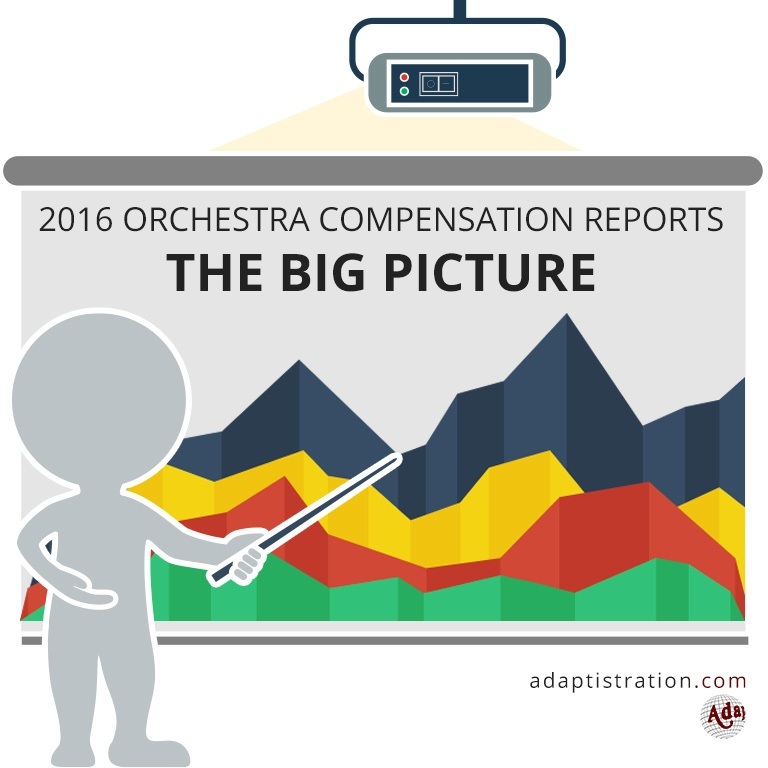The 2009/10 season was one of transition at a number of orchestras, especially the larger budget organizations. Several groups were amidst music director changes and/or in the middle of interim leadership and without those larger figures, the cumulative average compensation was lower than the previous season. However, if you remove the Top 10 Total Expenditure groups from the mix from both seasons, it is a different story.
WHAT’S NEW FOR THE 2012 REPORTS
 Although the reports cover the 2009/10 season, the orchestras which have liquidated and ceased operations since that time have been removed from the list (Honolulu, New Mexico, and Syracuse). If you’re curious about data from those organizations from the 2009/10 season through when they went bankrupt, you can still find their respective 990’s at guidestar.org.
Although the reports cover the 2009/10 season, the orchestras which have liquidated and ceased operations since that time have been removed from the list (Honolulu, New Mexico, and Syracuse). If you’re curious about data from those organizations from the 2009/10 season through when they went bankrupt, you can still find their respective 990’s at guidestar.org.
Likewise, some groups were removed due to an increase in the minimum total expenditure threshold to be included in the reports. At the same time, those were replaced by new entries including Fresno Phil, Monterey Symphony, National Symphony, Orchestra Iowa, Portland (ME) Symphony, and Sarasota Orchestra. Of those, National has traditionally been filtered out due to difficulty with extracting some of the figures from the overall Kennedy Center data and Sarasota flew under the radar for a few years due to their branding change (they used to be Florida West Coast Symphony).
“Where did the musician compensation figures go?”
In short, this year’s reports will not include that information. Detailed explanations are available in the series’ introduction article and in order to help make up for that missing data, this year’s reports will include compensation figures as well as the figures reported from the previous season. This should make it a bit easier for everyone to see dollar for dollar changes between seasons.
WHERE THE DATA COMES FROM
In order to provide information that is as accurate as possible, data from the 2009/10 season is gathered from the following sources:
- Music Director compensation figures were obtained from their respective orchestra’s IRS Form 990 for the 2009/10 concert season.
- Total Expenditures were also obtained from each respective orchestra’s IRS Form 990 for the 2009/10 concert season (due to their relationship within a larger performing arts structure, Total Expenditure figures for National Symphony and Atlanta Symphony are unavailable and the figures here are representative approximations).
Adaptistration makes no claim to the accuracy of information from documents compiled or reported by external sources. If you have reason to believe any of the information is inaccurate or has changed since reported in any of the above sources and you can provide documentation to such effect, please feel free to submit a notice.
WHAT THE NUMBERS DON’T SHOW
It is important to remember that the numbers shown do not always convey a complete compensation picture. For example, a music director may have had a large increase in salary due to leaving a position and per terms of the employment contract, may have received a sizeable severance or deferred compensation package. As such, the cumulative compensation may artificially inflate annual earnings.
Furthermore, these figures may not reflect bonuses or other incentive payments, therefore underreporting what conductors may actually earn nor do they include combined salary figures for conductors serving as music director for more than one orchestra. Also missing from the figures are expense accounts and other perks; as such, the cumulative compensation for music directors may or may not be more than what is listed. Additionally, the documents used to gather data do not indicate how much of the season an individual received a salary. As such, excessive differences in the change from the previous season’s compensation may be artificially adjusted.
Some organizations employ their music director as an independent contractor instead of a salaried employee; as such, they list music director compensation among the highest paid private contractors as opposed to employee compensation. In these instances, no information about benefits or deferred compensation is available.
Finally, in instances where music directors also perform as a featured soloist with their ensemble, these fees are sometimes negotiated under separate contract and reported separately yet for others, they are included in their music director contract.
2009/10 SEASON MUSIC DIRECTOR COMPENSATION
From the 2008/09 to the 2009/10 season…
- …the cumulative average music director compensation decreased 6.77 percent.
- …the average music director compensation, less the top ten ensembles with the highest Total Expenditures, increased 13.90 percent.
- …the Philadelphia Orchestra had the highest compensated orchestra music director at $ $1,827,801, although the individual was officially serving in a capacity of “Chief Conductor.”
- …the average orchestra Total Expenditure increased 7.75 percent.
TOP 10 EARNERS
- Philadelphia Orchestra: $1,827,801
- San Francisco Symphony: $1,801,627
- Boston Symphony: $1,321,779
- Dallas Symphony: $1,113,134
- New York Philharmonic: $1,082,277
- Cleveland Orchestra: $1,075,204
- Minnesota Orchestra: $1,035,622
- Saint Louis Symphony: $954,392
- Seattle Symphony: $699,048
- Baltimore Symphony: $685,812




It’d be really interesting to have a column in the table showing the MD salary as a percentage of budget, especially given the size of the compensation at Philly. Jeez – was that Eschenbach’s last year or Dutoit’s first as interim director?
And I presume this was Gilbert’s first year at the NYPO after the gigantic and undeserved $3 million to Maazel.
Lastly, Dear Mark, how many concerts did Jimmy actually conduct for his $1.3 million?
Correct on the NYPhill; they did list compensation for both Maazel and Gilbert but it was clearly a transitional season. As for Philadelphia, I believe that was Dutoit’s tenure.